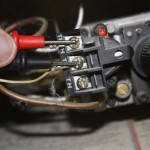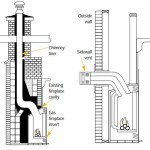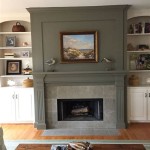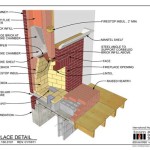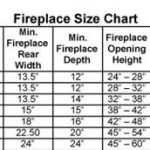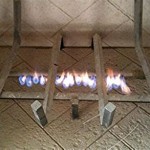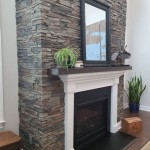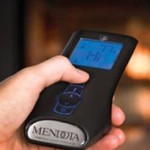Understanding Smoke Guards for Fireplaces: Functionality, Selection, and Safety
A fireplace, whether wood-burning, gas, or electric, offers a focal point for a room, providing warmth and ambiance. However, the functionality of a fireplace is directly linked to its ability to properly vent smoke and combustion byproducts. When a fireplace doesn't draft correctly, smoke can backdraft into the living space, posing health hazards and creating unpleasant odors. A smoke guard, also known as a smoke deflector or smoke shelf, is a component designed to improve the fireplace's draft and prevent smoke from entering the room.
This article will delve into the function of smoke guards, the factors to consider when selecting one, and the safety precautions associated with their installation and maintenance. We will explore different types of smoke guards and their impact on fireplace performance, ensuring a comprehensive understanding of this essential fireplace accessory.
The Functionality of a Smoke Guard
The primary function of a smoke guard is to improve the draft of a fireplace, thereby preventing smoke from escaping into the room. The natural draft of a fireplace relies on the principle of convection: hot air rises, creating a pressure difference that draws air up the chimney. When conditions are not ideal – such as a cold chimney, downdrafts caused by wind pressure, or insufficient air supply to the fire – the draft can be compromised, leading to smoke spillage.
A smoke guard works by modifying the airflow within the firebox and chimney. It typically consists of a metal plate or shield, often angled, that is positioned at the top of the firebox opening. This plate performs several crucial functions:
Redirecting Airflow: The angle of the smoke guard redirects the incoming air towards the fire. This helps to establish a stronger and more consistent updraft, preventing the smoke from swirling and escaping into the room. By creating a more directed flow, the smoke guard helps the combustion process by supplying oxygen to the fire more effectively.
Creating a Smoke Shelf: The smoke guard creates a small shelf or pocket above the firebox opening. This allows for a temporary accumulation of smoke and hot gases. This accumulation provides a buffer, preventing sudden gusts of wind or pressure changes from pushing the smoke back into the room. The smoke shelf also allows the smoke to heat up further before entering the chimney, enhancing the natural draft.
Deflecting Downdrafts: External factors, such as wind blowing across the chimney, can create downdrafts. These downdrafts push cold air down the chimney, counteracting the natural updraft and causing smoke to spill out of the fireplace. A smoke guard acts as a barrier, deflecting these downdrafts and preventing them from disrupting the airflow within the firebox. It helps to maintain a stable and consistent draft, even under unfavorable weather conditions.
Improving Combustion Efficiency: By directing airflow towards the fire, a smoke guard can contribute to more complete combustion. This means that more of the fuel is burned, resulting in less smoke and creosote buildup in the chimney. Improved combustion efficiency also translates to greater heat output, making the fireplace more effective at heating the room.
The effectiveness of a smoke guard depends on various factors, including the design of the fireplace, the size and shape of the firebox opening, and the characteristics of the chimney. Properly selecting and installing a smoke guard is crucial to maximizing its functionality.
Factors to Consider When Selecting a Smoke Guard
Choosing the right smoke guard for a fireplace requires careful consideration of several factors to ensure optimal performance and safety. A poorly chosen or improperly installed smoke guard can be ineffective or even create hazards.
Fireplace Dimensions and Design: The first step in selecting a smoke guard is to accurately measure the fireplace opening, including the width, height, and depth. The smoke guard must be appropriately sized to fit the opening and provide adequate coverage. The design of the fireplace is also a crucial factor. Fireplaces with shallow fireboxes or unusually shaped openings may require custom-made smoke guards.
Type of Fireplace: The type of fireplace – wood-burning, gas, or electric – will influence the choice of smoke guard. Wood-burning fireplaces produce more smoke and creosote than gas fireplaces, requiring a smoke guard that can effectively handle the increased volume of combustion byproducts. Electric fireplaces typically don't require smoke guards, as they don't produce smoke. However, a decorative shield might be used to enhance the appearance of the electric fireplace.
Material: Smoke guards are typically made of metal, such as steel or stainless steel. The material should be durable and heat-resistant to withstand the high temperatures within the firebox. Stainless steel is a popular choice due to its resistance to corrosion and its long lifespan. The gauge of the metal is also important; a thicker gauge will provide greater strength and durability.
Adjustability: Some smoke guards are adjustable, allowing for fine-tuning of the airflow within the firebox. This adjustability can be particularly useful for fireplaces with variable draft conditions. An adjustable smoke guard allows the user to optimize the airflow based on weather conditions and the type of fuel being burned.
Ease of Installation: The ease of installation is another important consideration. Some smoke guards are designed for easy installation, requiring only basic tools. Others may require professional installation, especially if modifications to the fireplace are necessary. It’s crucial to follow the manufacturer's instructions carefully and consult with a qualified professional if needed.
Aesthetics: While functionality is the primary concern, the aesthetics of the smoke guard should also be considered. It should blend in with the fireplace and complement the overall design of the room. Some smoke guards are designed with decorative elements, such as ornate patterns or a polished finish.
Local Codes and Regulations: Before installing a smoke guard, it's important to check local building codes and regulations to ensure compliance. Some jurisdictions may have specific requirements for fireplace accessories, including smoke guards. Failure to comply with these regulations can result in fines or other penalties.
Safety Precautions and Maintenance
Ensuring safe operation of a fireplace equipped with a smoke guard is paramount. Improper installation or lack of maintenance can lead to hazards such as fire, carbon monoxide poisoning, or damage to the fireplace and chimney.
Professional Installation: While some smoke guards can be installed by homeowners, professional installation is recommended, especially for more complex models or if modifications to the fireplace are required. A qualified professional can ensure that the smoke guard is properly positioned and secured, maximizing its effectiveness and safety.
Regular Inspections: The smoke guard should be inspected regularly for signs of damage, such as cracks, rust, or warping. Any damage should be repaired or replaced immediately to prevent safety hazards. The chimney should also be inspected and cleaned regularly to remove creosote buildup, which can contribute to chimney fires. A professional chimney sweep can perform these inspections and cleanings.
Carbon Monoxide Detectors: Carbon monoxide (CO) is a colorless, odorless gas that can be produced by incomplete combustion in a fireplace. Installing carbon monoxide detectors in the home is essential to provide early warning of dangerous CO levels. Detectors should be placed near sleeping areas and on each level of the home. Batteries should be tested regularly, and detectors should be replaced according to the manufacturer's recommendations.
Proper Ventilation: Ensuring adequate ventilation in the room is crucial for safe fireplace operation. A sufficient supply of fresh air is necessary for complete combustion and to prevent the buildup of carbon monoxide. If the fireplace is in a tightly sealed room, it may be necessary to open a window or door slightly to provide ventilation.
Burning Proper Fuel: Burning the correct type of fuel is essential for safe and efficient fireplace operation. Wood-burning fireplaces should only be used with seasoned hardwood, which burns cleanly and produces less smoke and creosote. Softwoods, painted wood, and treated wood should never be burned in a fireplace. Gas fireplaces should be operated according to the manufacturer's instructions, using the specified type of gas.
Clearances to Combustibles: Maintaining adequate clearances to combustible materials is crucial to prevent fires. Flammable materials, such as furniture, curtains, and paper, should be kept a safe distance from the fireplace. The manufacturer's instructions will specify the required clearances for the fireplace and any accessories, including the smoke guard.
Proper Disposal of Ashes: Ashes from wood-burning fireplaces should be disposed of properly to prevent fires. Ashes should be allowed to cool completely before being transferred to a metal container with a tight-fitting lid. The container should be placed on a non-combustible surface away from flammable materials. Never dispose of ashes in a paper bag or cardboard box.
By adhering to these safety precautions and maintenance guidelines, homeowners can enjoy the warmth and ambiance of their fireplaces while minimizing the risks associated with smoke spillage and other hazards. Regular maintenance and vigilant attention to safety are essential for ensuring the long-term performance and safety of a fireplace with a smoke guard.

Smoke Guards Dr Sweep

Hy C Fireplace Smoke Guard 6 Black Diy Chimney And

Smoke Guards Frontier Fireplaces

Fireplace Accessories Full Service Chimney

Smokeguard For Fireplaces Eliminate Fireplace Smoke Rockford Chimney

Magnetic Fireplace Ventilation Cover Removable Blocker Smoke Guard For Block Cold Air From Vent 91 44 15 24cm Com

Perpetua Iron Firescreens

28 5 X48 Adjustable Width Interior Fireplace Smoke Guard

Magnet Fireplace Screen Cover Removable Blocker Smoke Guard Household Furnitures Supplies 91 44 15 24cm Com

Why Does My Fireplace Smoke
Related Posts

